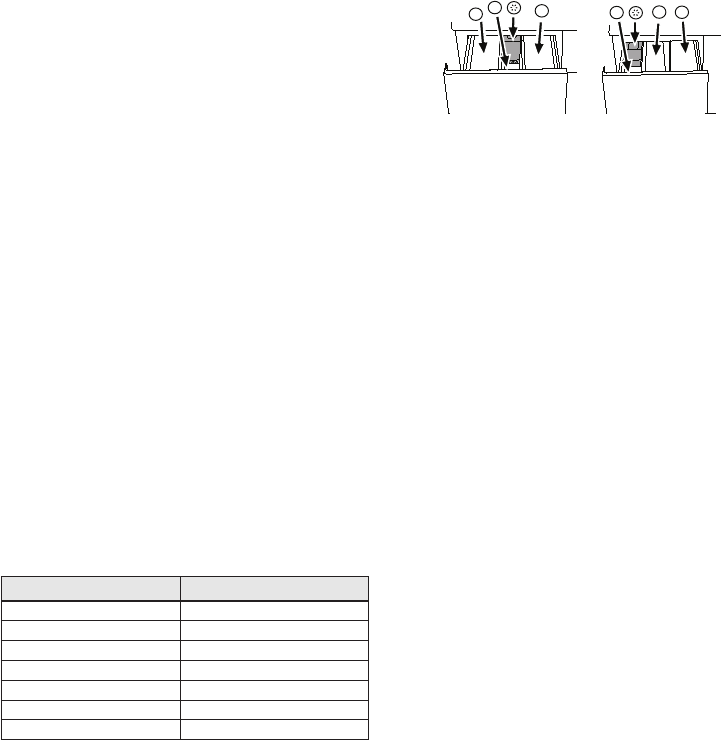
5 - EN
coins, pens and paper clips, and turn pockets
insideoutandbrush.Suchobjectsmay
damagetheproductorcausenoiseproblem.
• Putsmallsizeclothessuchasinfant'ssocks
andnylonstockingsinalaundrybagorpillow
case.
• Placecurtainsinwithoutcompressingthem.
Remove curtain attachment items.
• Fastenzippers,sewloosebuttonsandmend
rips and tears.
• Wash“machinewashable”or“handwashable”
labeledproductsonlywithanappropriate
programme.
• Donotwashcoloursandwhitestogether.New,
dark coloured cottons release a lot of dye.
Washthemseparately.
• Toughstainsmustbetreatedproperlybefore
washing.Ifunsure,checkwithadrycleaner.
• Useonlydyes/colourchangersandlimescale
removerssuitableformachinewash.Always
follow the instructions on the package.
• Washtrousersanddelicatelaundryturned
inside out.
• KeeplaundryitemsmadeofAngorawoolinthe
freezerforafewhoursbeforewashing.Thiswill
reduce pilling.
• Laundrythataresubjectedtomaterialssuchas
flour, lime dust, milk powder, etc. intensely must
beshakenoffbeforeplacingintothemachine.
Such dusts and powders on the laundry may
buildupontheinnerpartsofthemachinein
time and can cause damage.
Correct load capacity
The maximum load capacity depends on the type
of laundry, the degree of soiling and the washing
programme desired.
The machine automatically adjusts the amount
of water according to the weight of the loaded
laundry.
A
Follow the information in the “Programme
andconsumptiontable”.Whenoverloaded,
machine's washing performance will drop.
Moreover,noiseandvibrationproblemsmay
occur.
Laundry types and their average weights in the
followingtablearegivenasexamples.
Laundry type Weight(g)
Bathrobe 1200
Duvetcover 700
BedSheet 500
Pillowcase 200
Tablecloth 250
Towel 200
Men’s shirt 200
Loading the laundry
Open the loading door. Place laundry items loosely
into the machine. Push the loading door to close
until you hear a locking sound. Ensure that no items
are caught in the door.
C
The loading door is locked while a programme
isrunning.Thedoorcanonlybeopeneda
while after the programme comes to an end.
A
Incaseofmisplacingthelaundry,noiseand
vibrationproblemsmayoccurinthemachine.
Using detergent and softener
Detergent Drawer
The detergent drawer is composed of three
compartments:
- (1) for prewash
- (2) for main wash
–(3)forsoftener
–(*)inaddition,thereissiphonpieceinthesoftener
compartment.
1
2
3
1
23
Detergent, softener and other cleaning agents
• Adddetergentandsoftenerbeforestartingthe
washing programme.
• Neveropenthedetergentdrawerwhilethe
washing programme is running!
• Whenusingaprogrammewithoutprewash,
do not put any detergent into the prewash
compartment(compartmentnr.I).
• Inaprogrammewithprewash,donotput
liquiddetergentintotheprewashcompartment
(compartmentnr.I).
• Donotselectaprogrammewithprewashifyou
areusingadetergentbagordispensingball.
Placethedetergentbagorthedispensingball
directly among the laundry in the machine.
• Ifyouareusingliquiddetergent,donotforget
toplacetheliquiddetergentcupintothemain
washcompartment(compartmentnr.II).
Choosing the detergent type
Thetypeofdetergenttobeuseddependsonthe
typeandcolourofthefabric.
• Usedifferentdetergentsforcolouredandwhite
laundry.
• Washyourdelicateclothesonlywithspecial
detergents(liquiddetergent,woolshampoo,
etc.) used solely for delicate clothes.
• Whenwashingdarkcolouredclothesand
quilts,itisrecommendedtouseliquid
detergent.
• Washwoolenswithspecialdetergentmade
specifically for woolens.
A
Useonlydetergentsmanufacturedspecifically
for automatic washing machines.
A
Donotusesoappowder.
Adjusting detergent amount
Theamountofwashingdetergenttobeused
depends on the amount of laundry, the degree
of soiling and water hardness. Read the
manufacturer's instructions on the detergent
package carefully and follow the dosage values.
• Donotuseamountsexceedingthedosage
quantitiesrecommendedonthedetergent
packagetoavoidproblemsofexcessive


















